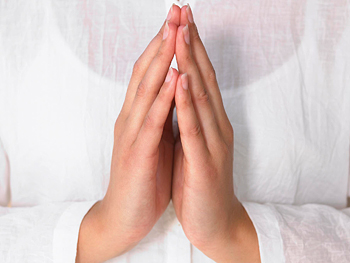Anjali Mudra (Prayer Seal)

We use this Mudra in class a lot, so what is a mudra? What is the one pictured called and what is its purpose?
Mudra in Sanskrit (ancient Indian language) means an attitude or gesture by a part of your body. It also refers to a part of your body that is sealed or closed off. Many of the mudras used in yoga, meditation and pranayama are quite involved and practiced by experienced yogis; others are easier like the one shown here.
When mudras are combined with a yoga pose they have a subtle yet profound effect on mental and spiritual aspects. They can also be used during meditation, relaxation and pranayama practice. There are dozens of mudras, and each represents a certain quality, such as compassion, courage or wisdom.
Anjali Mudra (Prayer Seal)
This mudra is often seen in India, where people use it to greet, thank, and express respect. Yoga classes often begin and end with this mudra as it is a reminder to come back to your centre and that your practice is a form of prayer or offering to your true Self.
By joining your hands together, you make a physical gesture of union, (a symbolic reference of the union of your individual self and the Universal Self), in which you are aware of the inter-connectedness of all living beings.
The gentle pressure of the two palms against each other is believed to harmonize the left and right hemispheres of the brain. When you also press the thumbs against your breast bone you remind yourself to cultivate the qualities of the heart.
Quotes:
- "Some of us may find a subconscious resistance to bringing our hands together as if it were a sign of submission. However, the beauty of this gesture, which positions us right at the core of our being, is timeless and universal." ~ Shiva Rae (Meet in the Middle: Anjali Mudra) for Yoga Journal.
- "The traditional Anjali mudra is the palms folded together with a small space left in the center and the thumbs touching the heart center. This space in the center represents the hidden inner light that is within each person. It is protected and revered and connected to the compassionate heart. The head bows to this heart center and the gaze is also brought downwards to the hands. All focus and concentration is on this inner flame and intention." ~ Rexburg Yoga.
-
"We practice this Mudra in meditation, in different asanas like tadasana and tree pose, and to seal our practice with namaste. After so many classes, it is easy to go through the motions and not connect with why we are doing it... Anjali positions us at the core of our being, and is a timeless and universal gesture of honoring and celebrating your relationship with the divine." ~ Forever Stoked."Practicing Anjali Mudra is an excellent way to induce a meditative state of awareness." ~ Unknown.
This was used as the Spirit Yoga Theme for the week, and is also a section from the Spirit Yoga, Breathing (Pranayama) Booklet.




